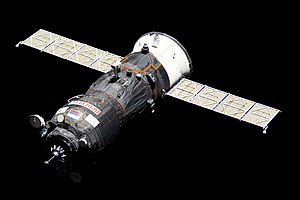
Back Progress AN بروغريس (مركبة فضائية) Arabic Прогрес (космически кораб) Bulgarian প্রোগ্রেস (মহাকাশযান) Bengali/Bangla Progress (nau espacial) Catalan Progress Czech Progress (rumfartøj) Danish Progress German Progress Esperanto Progress Spanish
 Progress MS-11 spacecraft in space | |
| Country of origin | Soviet Union / Russia |
|---|---|
| Operator | Roscosmos |
| Applications |
|
| Specifications | |
| Spacecraft type | Cargo |
| Payload capacity | 2,400 kg (5,300 lb) |
| Volume | 7.6 m3 (270 cu ft) |
| Design life | 180 days docked to a space station[a] |
| Dimensions | |
| Length | 7.23 m (23.7 ft) |
| Diameter | 2.72 m (8 ft 11 in) |
| Production | |
| On order | 8 |
| Built | 182 |
| Operational | 2 (MS-28, MS-29) |
| Retired | 177 |
| Lost | 3 (M-12M, M-27M, MS‑04) |
The Progress (Russian: Прогресс) is a Russian expendable cargo spacecraft. Originally developed for the Soviet space program and derived from the crewed Soyuz spacecraft, Progress has been instrumental in maintaining long-duration space missions by providing consumables like food, water, and air, as well as maintenance equipment. Since its maiden flight in 1978, Progress has supported various space stations, including Salyut 6, Salyut 7, and Mir, and remains a key resupply vehicle for the International Space Station (ISS).
Each Progress mission delivers thousands of kilograms of supplies in its pressurized module. It also carries water, fuel, and gases to replenish the station's resources and sustain its onboard atmosphere. Beyond resupply duties, a docked Progress can maneuver or reboost the station, countering atmospheric drag and maintaining its operational altitude. When a Progress spacecraft nears the end of its design life, it is loaded with waste, undocked, and deorbited to safely disintegrate in Earth's atmosphere.
As of November 2024[update], there have been 182 Progress flights, with only three failures, all occurring between 2011 and 2016. Typically, three to four Progress flights are launched to the ISS each year. Due to the variation in Progress vehicles flown to the ISS, NASA uses its own nomenclature where "ISS 1P" means the first Progress spacecraft to ISS.
Cite error: There are <ref group=lower-alpha> tags or {{efn}} templates on this page, but the references will not show without a {{reflist|group=lower-alpha}} template or {{notelist}} template (see the help page).